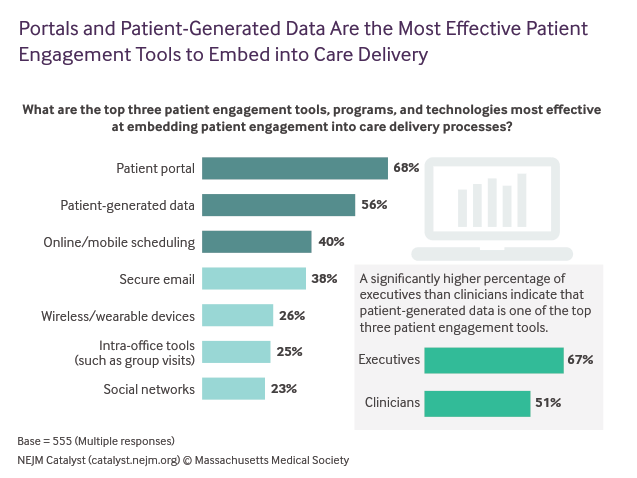
Recent survey by NEJM Catalyst sums up that effective patient engagement has major impact on the quality of care, according to 60% of clinicians and health system leaders. Moreover, around 40% of respondents believe the effort in this field may cause substantial decrease in healthcare cost.
However, traditional personnel-heavy approach to promoting better patient engagement - regular doctor checkout, hospital readmission, in-person medication adherence monitoring, etc. - proves to be outdated and costly itself. Therefore, the industry increased reliance on the technology in this area and expects the efforts in the field to bring up next-gen digital tools for patient engagement.
Today, some time-proven patient engagement tools already rely on big technology including AI, IoT and virtual assistants. Patient portals, patient data processing systems and mobile solutions make the largest part among the promising tools in this regard. Though, each of these standard-bearers has its own problem that hampers patient engagement efforts.

Patient portals are endorsed as a top patient engagement tool by 68% of professional clinicians and industry leaders. Apart from varied efforts to educate healthcare staff and promote better adoption of patient portals among customers, industry leaders strive to smoothly incorporate this tool into existing care workflows and create new patient-centric infrastructure where patient portals are accessible and ubiquitous.
Recent article in The New England Journal of Medicine, however, brings up the pressing issue of outdated security and privacy requirements that dominate in healthcare today.
Apparently, conservative HIPAA regulations with more than 20 year-old history limit the capabilities of modern patient portals. In turn, patient portals backed by HIPAA-protected patient data privacy terms fail to meet the requirements set for an efficient patient engagement solution - fast access to patient data, instant sharing and transfer of medical information, direct personalized communication. As a result, inflexible privacy regulations hamper the potential of patient portals and cut off their benefits as a patient engagement tool.
What can be done
Healthcare leaders already realize the issue and understand the pressure of delay and consequence of inaction in terms of HIPAA modernization. We can expect reforms and introduction of more elastic legislation in this field.
Until then, the industry is open to alternative engaging solutions that encourage patients to monitor and update their health data. For example, platforms like drchrono’s onpatient EHR for patients available on all Apple devices including Apple Watch. Or in-house digital tools for patients widely used within Kaiser Permanente health care infrastructure.
Lack of actionable data holds up patient engagement technology
Healthcare collects massive amount of raw patient data: health records, hospital admission and medication intake information, medical procedures reports, as well as updating health conditions data collected by personal wearables and mobile devices.
Meanwhile, it is patient data that empowers next-gen patient engagement tools. According to the Catalyst research mentioned before, patient-generated data forms 56% of potential basis for patient engagement tools. Clinicians and healthcare executives believe it to be the second most important standard-bearer of patient engagement efforts.
However, the industry uses only a small part of this data. The rest stays in silos and never turns into actionable insights. Despite the evident value, great part of patient-generated data remains locked either in legacy healthcare operations such as paper-based health records or strict and highly regulated data policies (hint: 20-year-old HIPAA). Some of this data is greatly overlooked, hence, rarely collected. For example, patient satisfaction and outcome.
As a result, the lack or misuse of patient data hampers the improvement of modern patient engagement technology - personalization of healthcare tools, treatment monitoring apps, predictive analytics for patient management.
What can be done
High-end technologies such as IoT and AI rely on large volume of constantly updating patient data. This hunger encourages companies to harvest more data and extract as much value as possible. Today, emerging sensor and tracking-based IoT solutions for healthcare such as connected hospitals or social care infrastructures focus on leveraging patient data to provide smooth, more personalized patient journeys.
For example, Z-Works’s connected hospital allows to automate patient admission and discharge thanks to smart tracking and greatly improves patient experience. While AI-enabled virtual therapist Woebot collects patient data via chat, gradually customizes dialogues and provides highly personalized advice based on patient’s behavioural specifics.
Design of digital tools does not entirely address patient needs
The industry doesn’t experience the shortage of digital products for patient engagement, such as apps for appointment scheduling, medication intake monitoring, symptom tracking. However, the majority of existing mobile and web systems lack personalization and fail to address the needs and requirements of different categories of patients.
Hardly do many mobile apps with simple functionality, say doctor appointment scheduling, adjust to user’s technical skills or abilities. Instead, designers and engineers create individual mobile tools focused on a certain target audience, be it the elderly, children or people with special needs.
This approach works, but seems inefficient in the era or progressing technologies and connected everything. In reality, the industry needs more forward-looking solutions able to equalily address the needs of various user categories and provide personalized patient experience in the omnichannel environment.
What can be done
Patient engagement tools able to leverage personalization and context exist. Often, they are based on such trendy technologies as AI-enabled chatbots and voice assistants. For example, HealthTap Dr. A.I. that operates on various mobile devices and Alexa and applies complex algorithms to adjust its interface to particular user’s needs and context.
Though, industry-proven tools in the field are rare. Not surprisingly, the biggest challenge in the design and development of such tools is strongly related to the problems already familiar to the reader - privacy policy restrictions and lack of actionable patient data.
For example, to build a truly efficient chatbot able to adjust conversations to patient’s age, technical skills, health conditions and maneuver the dialogue using previously acquired patient information means to integrate strong NLP capabilities into the system.
Today, well-known NLP engines improve with tremendous pace. To improve, they need user data - patient data in case of healthcare. To get this data, they need authorised access. Here comes the vicious circle.
Therefore, it’s still the matter of time when digital tools for patient engagement, for example, mobile apps, chatbots on Messenger or Alexa Skills, will be able to operate with deep understanding of the context and fully address customer needs.
As you see, three most endorsed and relied upon patient engagement technologies share the same set of problems - restricted access to patient data, outdated regulations and policies and shortage of forward-looking design concepts and capabilities. Fortunately, modern technology synergy is able to bypass these problems and create a new generation of patient engagement tools focused on improved healthcare experience and patient satisfaction.
Edited by
Mandi Nowitz